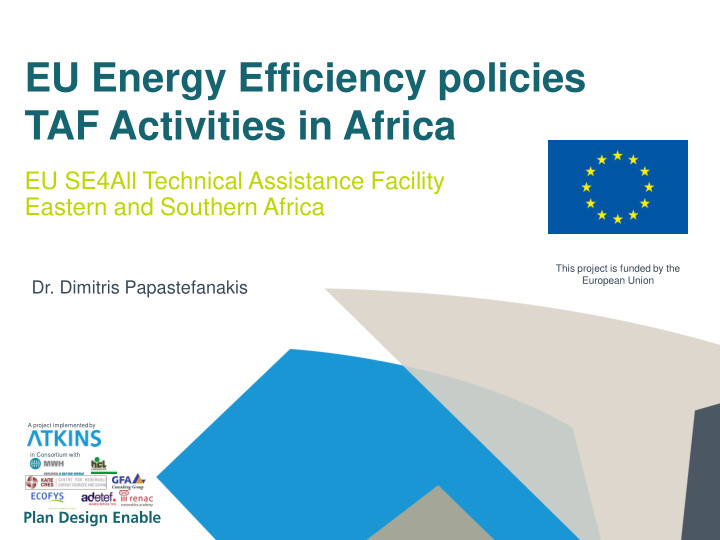



EU Energy Efficiency policies TAF Activities in Africa EU SE4All Technical Assistance Facility Eastern and Southern Africa This project is funded by the European Union Dr. Dimitris Papastefanakis A project implemented by in Consortium with
Energy in the EU Milestones • Energy policy strategy for the Community 1974 Achievements • Single European Act - Environmental 20/20/20 targets protection 1987 1997 • 1 st Package: Electricity Liberalization ● 18 % reduction of Greenhouse Gas Emissions (1990 – 2011) 2003 • Renewables Directives 2001 ● 15.5 % Energy Efficiency Savings • 2 nd Package: Energy Market (2013) 2003 Liberalization 2005 • Emissions Trading ● 15 % Share of Renewable Energy (2013) 2007 • Energy Action Plan – 20/20/20 targets • 3 rd Package: Harmonised Internal Energy Market 2009 2015 • Energy Union Source: Canevari C., Energy Efficiency in the EU: Where We Are; Where We Will Be, EXPO 2015 High- 2 level Workshop on Energy Efficiency and Sustainability, Milan, Italy, 10 July 2015
EU Energy – The way Forward The Energy Union Where the EU wants to go: A secure, sustainable, competitive, affordable energy for every European What this means: • Energy security, solidarity and trust • A fully integrated internal energy market • Energy efficiency first • Transition to a long-lasting low-carbon society • An Energy Union for Research, Innovation and Competiveness 3
Energy in EU & Growth ● Primary energy consumption 1995 ≈ 2013 (~1570 Mtoe) ● GDP in 2013 ~3 trillion € higher than 1995. ● Economic growth is decoupled from energy consumption Source: Energy Efficiency Communication 2014 – COM (2014) 520 4
TAF EE Activities & EU EE Policies • AUC: Development of Energy Energy Efficiency Harmonization Agenda and Action Plan at Directive 2012/27/EU Continental • Covenant of Mayors Energy Performance Ecodesign of Buildings Directive • COMESA: Elaboration and implementation Directive 2009/125/EC 2010/31/EU of regional (EA-SA-IO) energy sector policies and reforms Energy Labelling • COMESA – ECOWAS - SADC: Training, Directive 2010/30/EU Study Tour, RES and EE Strategy • SADC: RES and energy efficiency strategy and action plan Energy Efficiency is an Energy Source in its own right 5
EE - Transport • 33 % of final Energy Consumption • 27% decrease in the average consumption of new cars (2010 vs 1995) • Directive 715/2007/EC - European Emission Standards / Euro 6 for both Diesel and Petrol from 2014 • Directive 94/2014, electric vehicles : target of 1 charging station per 10 vehicles by 31/12/2020, 38 000 electric vehicles were registered in the EU in 2014 • Directive 2009/28/EC, biofuels: target of 10% share of renewable energy in transport by 2020, biofuels contribution half EU Member at least 5% • Labelling scheme for vehicle tires Tires and tire pressure can lead to over 5% fuel efficiency increase • Increased deployment of clean fuels • Eco-driving promotion activities Source: Ladefoged N., EU Energy Policy, EUROSAI WGEA Spring session on Auditing Energy Issues, Tallinn, Estonia, 23 April 2015
EE - Industry • 26 % of final Energy Consumption • 25 % Reduction of Final Energy Ongoing EU TAF Activities in Consumption across all industrial Africa sectors (1990 vs 2014) Zambia: Policy and regulatory • 22 % Technical potential to reduce framework - Energy Efficiency energy consumption ( 5 - 8 % energy Quick Win Actions consumption reduction measures have Ethiopia & Tanzania: Least cost only 2 years payback period) planning, pilot energy efficiency • Energy audits every 4 years for all projects Large Enterprises are required Mozambique: Projects • National initiatives: voluntary identification agreements, tax incentives etc • Horizon 2020: Support Research and Innovation in Industry 7 Source: Canevari C., Energy Efficiency in the EU: Where We Are; Where We Will Be, EXPO 2015 High-level Workshop on Energy Efficiency and Sustainability, Milan, Italy, 10 July 2015
EE - Buildings • Ongoing EU TAF Activities in 38 % of the Final Energy Consumption (residential and tertiary sector) Africa • 4% Reduction of Final Energy Tanzania: Paving the way towards Consumption in the residential sector Energy Performance Certification in (1990 vs 2014) Buildings • Only 0.1 % per year demolition rate and 1.2 % per year refurbishment rate Madagascar: Promotion solar • thermal for sanitary water 90% of refrigerators meet the highest energy efficiency labelling classes (above Zambia: Policy, Indicators Energy A) Efficiency • 80 % of the economic potential of EE in buildings remains untapped Energy Performance of Buildings Directive 2010/31/EU – Energy Performance Certification of Buildings, National Plans, Energy Performance Eco-design Directive (2009/125/EC and Energy Labeling Directive 2010/30/EU – Energy performance of building products Energy Efficiency Directive 2012/27/EU – 3% yearly renovation for central government, nearly-zero energy buildings, long term renovation roadmaps 8 Source: Ladefoged N., EU Energy Policy, EUROSAI WGEA Spring session on Auditing Energy Issues, Tallinn, Estonia, 23 April 2015
Recommend
More recommend